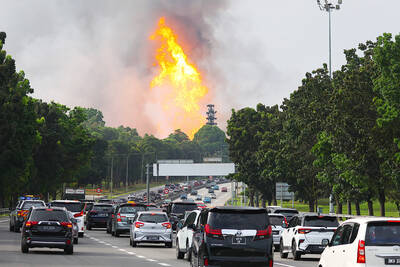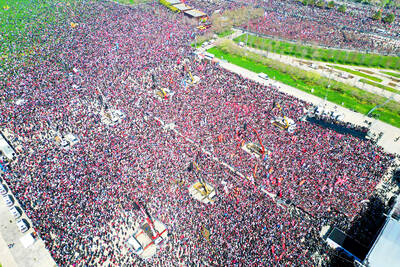A crowded passenger train slammed into a stationary freight train in western India early yesterday, throwing cars off the tracks and killing at least 24 people, a top railway official said.
At least 94 people were injured, 20 of them seriously, in the collision in Samlaya, a village at Gujarat state.
It was not immediately clear what caused the accident, though one official said a signal failure might be to blame.

PHOTO: EPA
Soldiers used metal cutters to extract about 80 passengers trapped in a coach that had climbed over another, as anxious relatives awaited word about their loved ones.
"I was sleeping when I fell from the upper berth. There was a deafening crash. We tried getting out of the coach, but the door was jammed," said passenger Preeti Thakkar, 23, who was in a hospital with an injured collarbone from her fall.
The accident occurred when a passenger train coming from the Hindu pilgrimage city of Varanasi hit the freight train at the Samlaya station, about 36km west of the city of Vadodara. At least five of the cars derailed and fell on their sides.
Federal Railway Minister Laloo Prasad Yadav was heckled by a crowd of about 1,000 and stones were thrown at his car when he visited the main hospital in Vadodara where 72 of the injured were being treated. No one was injured in the confrontation.
Earlier, Yadav visited the crash site and spoke to railway officials but did not speak to the hundreds of passengers and their relatives still at Samlaya station.
"It took the railway minister more than eight hours to reach the site. And when he reached the hospital, the police would not let us talk to him," said Navin Shah, who was searching for his father, a passenger on the train.
Villagers from Samlaya and other nearby communities were the first to reach the train and began pulling people out of the fallen coaches.
Firefighters and soldiers used a hydraulic ladder to reach the top of a coach that had climbed over another and cut through the top with blowtorches to rescue people trapped inside.
Railway officials said that at least 432 passengers were aboard.
"We fear around 80 people are still trapped in one of the coaches," said Gujarat railway minister Narayan Singh Rathore, who was supervising the rescue operation.
Many of the passengers were sleeping when the accident occurred around 3:30am.
"It was terrible. People were screaming in the dark and everyone was pushing to get out of the train," said Thakkar, who was traveling with her parents.
After about two hours, Thakkar said, soldiers were able to cut through the door of the coach and pull out those trapped inside. Thakkar was taken to hospital by rescue workers and said she had no word about her parents.
"I don't know about my parents. I have not seen them since it happened," she said, weeping.

A fire caused by a burst gas pipe yesterday spread to several homes and sent a fireball soaring into the sky outside Malaysia’s largest city, injuring more than 100 people. The towering inferno near a gas station in Putra Heights outside Kuala Lumpur was visible for kilometers and lasted for several hours. It happened during a public holiday as Muslims, who are the majority in Malaysia, celebrate the second day of Eid al-Fitr. National oil company Petronas said the fire started at one of its gas pipelines at 8:10am and the affected pipeline was later isolated. Disaster management officials said shutting the

US Vice President J.D. Vance on Friday accused Denmark of not having done enough to protect Greenland, when he visited the strategically placed and resource-rich Danish territory coveted by US President Donald Trump. Vance made his comment during a trip to the Pituffik Space Base in northwestern Greenland, a visit viewed by Copenhagen and Nuuk as a provocation. “Our message to Denmark is very simple: You have not done a good job by the people of Greenland,” Vance told a news conference. “You have under-invested in the people of Greenland, and you have under-invested in the security architecture of this

UNREST: The authorities in Turkey arrested 13 Turkish journalists in five days, deported a BBC correspondent and on Thursday arrested a reporter from Sweden Waving flags and chanting slogans, many hundreds of thousands of anti-government demonstrators on Saturday rallied in Istanbul, Turkey, in defence of democracy after the arrest of Istanbul Mayor Ekrem Imamoglu which sparked Turkey’s worst street unrest in more than a decade. Under a cloudless blue sky, vast crowds gathered in Maltepe on the Asian side of Turkey’s biggest city on the eve of the Eid al-Fitr celebration which started yesterday, marking the end of Ramadan. Ozgur Ozel, chairman of the main opposition Republican People’s Party (CHP), which organized the rally, said there were 2.2 million people in the crowd, but

JOINT EFFORTS: The three countries have been strengthening an alliance and pressing efforts to bolster deterrence against Beijing’s assertiveness in the South China Sea The US, Japan and the Philippines on Friday staged joint naval drills to boost crisis readiness off a disputed South China Sea shoal as a Chinese military ship kept watch from a distance. The Chinese frigate attempted to get closer to the waters, where the warships and aircraft from the three allied countries were undertaking maneuvers off the Scarborough Shoal — also known as Huangyan Island (黃岩島) and claimed by Taiwan and China — in an unsettling moment but it was warned by a Philippine frigate by radio and kept away. “There was a time when they attempted to maneuver